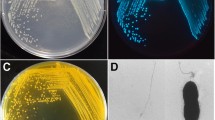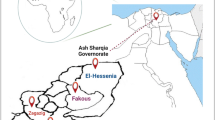Abstract
Foodborne viruses are a common and, probably, the most under-recognized cause of outbreaks of gastroenteritis. Among the main foods involved in the transmission of human enteric viruses are mollusks, and fruits and vegetables irrigated with wastewater and/or washed with non-potable water or contaminated by contact with surfaces or hands of the infected personnel during its preparation. In this study, 134 food samples were analyzed for the detection of Norovirus, Rotavirus, and Hepatitis A virus (HAV) by amplification of conserved regions of these viruses. From the 134 analyzed samples, 14 were positive for HAV, 6 for Norovirus, and 11 for Rotavirus. This is the first report in Mexico where emphasis is given to the presence of HAV and Norovirus on perishable foods and food from fisheries, as well as Rotavirus on frozen vegetables, confirming the role of vegetables and bivalve mollusks as transmitting vehicles of enteric viruses.



Similar content being viewed by others
References
Barker, S. F., Amoah, P., & Drechsel, P. (2014). A probabilistic model of gastroenteritis risks associated with consumption of street food salads in Kumasi, Ghana: Evaluation of methods to estimate pathogen dose from water, produce or food quality. Science of the Total Environment, 487, 130–142.
Bean, N. H., Griffin, P. M., Goulding, J. S., & Ivery, C. B. (1990). Foodborne disease ourbreaks, 5 year summary, 1983–1987. Morbidity and mortality weekly report. CDC Surveillance Summaries (2010)/Centers for Disease Control, 39(1), 15–57.
Burkhardt, W., & Calci, K. R. (2000). Selective accumulation may account for shellfish-associated viral illness. Applied and Environmental Microbiology, 66(4), 1375–1378.
Butot, S., Putallaz, T., & Sanchez, G. (2006). Procedure for rapid concentration and detection of enteric viruses from berries and vegetables. Applied and Environmental Microbiology, 73(1), 186–192.
Centers for diseases control and prevention (CDC) (2012). Noroviruses. CDC, Atlanta. www.cdc.gov/ncidod/dvrd/revb/gastro/norovirus.htm. Accessed 30 Jul 2012.
Centers for diseases control and prevention (CDC) (2015). Viruses. CDC, Atlanta. www.cdc.gov/ncidod/dvrd/revb/gastro/norovirus.htm. Accessed 30 Jun 2015.
Cromeans, T., Sobsey, M. D., & Fields, H. A. (1997). Development of a plaque assay for a cytopathic, rapidly replicating isolate of Hepatitis A virus. Journal of Medical Virology, 22(1), 45–56.
El-Senousy, W. M., Ragab, A. M., & Handak, E. M. (2015). Prevalence of rotaviruses groups A and C in Egyptian children and aquatic environment. Food and Environmental Virology, 7(2), 132–141.
Food and Agriculture Organization of the United Nations and World Health Organization (FAO and WHO) (2008). Viruses in food: Scientific advice to support risk management activities. (Microbiological risk assessment series no. 13). WHO Library Cataloguing-In-Publication Data.
Gouvea, V., Glass, R. I., Woods, P., Taniguchi, K., Clark, H. F., Forrester, B., & Fang, Z. Y. (1990). Polymerase chain reaction amplification and typing of rotavirus nucleic acid from stool specimens. Journal Clinical Microbiology, 28(2), 276–282.
Ha, J. H., Choi, C., & Ha, S. D. (2014). Evaluation of immunomagnetic separation method for the recovery of Hepatitis A virus and GI.1 and GII.4 Norovirus strains seeded on oyster and mussel. Food and Environmental Virology, 6(4), 290–296.
Hewitt, J., & Greening, G. E. (2004). Survival and persistence of norovirus, Hepatitis A virus, and feline calicivirus in marinated mussels. Journal of Food Protection, 67(8), 1743–1750.
Kittigul, L., Singhaboot, Y., Chavalitshewinkoon-Petmitr, P., Pombubpa, K., & Hirunpetcharat, C. (2015). A comparison of virus concentration methods for molecular detection and characterization of rotavirus in bivalve shellfish species. Food Microbiology, 46, 161–167.
Ko, S. M., Vaidya, B., Kwon, J., Lee, H. M., Oh, M. J., Shin, T. S., et al. (2015). Detection of Hepatitis A virus in seeded oyster digestive tissue by ricin A linked magnetic separation combined with reverse transcription PCR. Journal of Food Protection, 78(5), 1046–1051.
Kou, X., Wu, Q., Zhang, J., & Fan, H. (2006). Rapid detection of noroviruses in fecal samples and shellfish by nucleic acid sequence-based amplification. Journal of Microbiology, 44(4), 403–408.
Lamhoujeb, S., Fliss, I., Ngazoa, S., & Jean, J. (2008). Evaluation of the persistence of infectious human Noroviruses on food surfaces by using real-time nucleic acid sequence-based amplification. Applied and Environmental Microbiology, 74(11), 3349–3355.
Le Guyader, L., Haugarreau, L., Dubois, E., & Pommepuy, M. (2000). Three-year study to assess human enteric viruses in shellfish. Applied and Environmental Microbiology, 66(8), 3241–3248.
Mattison, K., Karthikeyan, K., Abebe, M., Malik, N., Sattar, S. A., Farber, J. M., & Bidawid, S. (2007). Survival of calicivirus in foods and on surfaces: Experiments with feline calicivirus as a surrogate for norovirus. Journal of Food Protection, 70(2), 500–503.
Moreno, S., Alvarado, M., Bermudez, A., & Gutierrez, M. (2009). Análisis filogenético de las cepas de rotavirus y virus de la Hepatitis A virus encontradas en agua de consumo en el municipio de Quibdó, Chocó. Biomedica, 29, 209–217.
Pacilli, M., Cortese, M. M., Smith, S., Siston, A., Samala, U., Bowen, M. D., et al. (2015). Outbreak of gastroenteritis in adults due to rotavirus genotype G12P8. Clinical Infectious Diseases, 61(4), e20–e25.
Parashar, U. D., Gibson, C. J., Bresee, J. S., & Glass, R. I. (2006). Rotavirus and severe childhood diarrhea. Emerging Infectious Diseases, 12(2), 304–306.
Polo, D., Varela, P., & Romalde, M. (2015). Detection and quantification of Hepatitis A virus and norovirus in Spanish authorized shellfish harvesting areas. International Journal of Food Microbiology, 193(2015), 43–50.
Rajko-Nenow, P., Keaveney, S., Flannery, J., O`Flaherty, V., & Dore, W. (2012). Characterization of norovirus contamination in an Irish shellfishery using real time RT-qPCR and sequencing analysis. International Journal of Food Microbiology, 160(2), 105–112.
Rodríguez-Díaz, J., Querales, L., Caraballo, L., Vizzi, E., Liprandi, F., Takiff, H., & Betancourt, W. (2009). Detection and characterization of waterborne gastroenteritis viruses in urban sewage and sewage-polluted river waters in CaracasVenezuel. Applied Environmental Microbiology, 75(2), 387–394.
Sair, A. I., D’Souza, D. H., & Jaykus, L. A. (2002). Human enteric viruses as causes of foodborne diseases. Comprehensive Reviews in Food Science and Food Safety, 1(2), 73–89.
Santosham, M., Chandran, A., Fitzwater, S., Fischer-Walker, C., Baqui, A., & Black, R. (2010). Progress and barriers for the control of diarrhoeal disease. Lancet, 376(9734), 63–67.
Secretaría de Salud (SSA) (2012). Perfil Epidemiológico de las Enfermedades Infecciosas Intestinales. Subsecretaría de Prevención y Promoción de la Salud Dirección General de Epidemiología, Sistema Nacional de Vigilancia Epidemiológica/Dirección General de Información Epidemiológica/Salud. México.
Verhoef, L., Vennema, H., Van-Pelt, W., Lees, D., Boshuizen, H., Henshilwood, K., & Koopmans, M. (2010). Use of norovirus genotype profiles to differentiate origins of foodborne outbreaks. Emerging Infectious Diseases, 16(4), 617–624.
Vilariño, M. L., Le Guyader, F. S., Polo, D., Schaeffer, J., Kröl, J., & Romalde, J. L. (2009). Assessment of human enteric viruses in cultured and wild bivalve molluscs. International Microbiology, 12(3), 145–151.
Yilmaz, H., Bostan, K., Turan, N., Muratoglu, K., Yilmaz, A., Ozkul, A. A., et al. (2010). Real-time PCR detection of norovirus in mussels collected from the bosphorus in Istanbul Turkey. Food and Environmental Virology, 2(2), 64–68.
Author information
Authors and Affiliations
Corresponding author
Rights and permissions
About this article
Cite this article
Parada-Fabián, J.C., Juárez-García, P., Natividad-Bonifacio, I. et al. Identification of Enteric Viruses in Foods from Mexico City. Food Environ Virol 8, 215–220 (2016). https://doi.org/10.1007/s12560-016-9244-6
Received:
Accepted:
Published:
Issue Date:
DOI: https://doi.org/10.1007/s12560-016-9244-6




